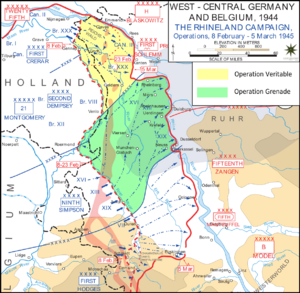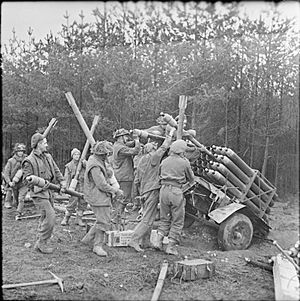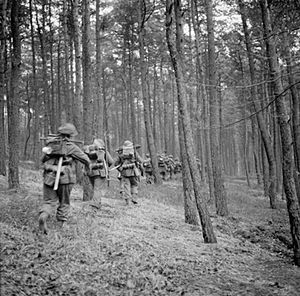Operation Veritable facts for kids
Quick facts for kids Operation Veritable |
|||||||
|---|---|---|---|---|---|---|---|
| Part of the Western Allied invasion of Germany in the Western Front of the European theatre of World War II | |||||||
 Operations Veritable and Blockbuster (yellow) and Grenade (green) |
|||||||
|
|||||||
| Belligerents | |||||||
| Commanders and leaders | |||||||
| Strength | |||||||
| 200,000 men 1,400 guns 35,000 vehicles |
90,000 men 1,054 guns 700 mortars |
||||||
| Casualties and losses | |||||||
| 15,634 casualties | ~44,239 casualties (Canadian First Army Estimate) | ||||||
Operation Veritable was a major battle during the final part of World War II. It happened between February 8 and March 11, 1945. This operation was the northern part of a "pincer movement" by the Allied forces. A pincer movement is when two groups attack from different sides to trap the enemy.
The operation was led by Field Marshal Bernard Montgomery's Anglo-Canadian forces. These included the First Canadian Army and the British XXX Corps. The goal was to push into Germany and clear the area between the Rhine and Maas rivers.
The British XXX Corps moved through the Reichswald Forest. At the same time, the 3rd Canadian Division used special vehicles to cross flooded areas. The fighting was very tough. The Allies advanced slower than they hoped. This was partly because the Germans flooded the Ruhr River, delaying the American attack (called Operation Grenade). This allowed the Germans to focus their defense against the British and Canadians.
Despite the challenges, the Allies kept moving forward. By February 22, they had captured the towns of Kleve and Goch. The attack then continued as Operation Blockbuster. On March 4, the Allied forces met up with the U.S. Ninth Army near Geldern. The Germans tried to hold onto a small area near Wesel to let their soldiers escape. But by March 10, their withdrawal ended, and the last bridges were destroyed.
Contents
Why the Allies Attacked Germany
General Dwight D. Eisenhower, the top Allied commander, decided the best way into Germany was through the flat lands of northern Europe. This area included the important industrial region called the Ruhr. To do this, Allied forces first needed to reach the Rhine River along its entire length.
In late 1944, Montgomery's 21st Army Group was positioned along the River Maas. They planned several attacks to secure their position near Nijmegen, which had important bridges. One plan, called Valediction, was chosen for the First Canadian Army. The British XXX Corps joined the Canadians for this operation. It was later renamed Veritable.
The operation was supposed to start on January 1, 1945. However, it was delayed because forces were needed to stop a German attack in the Ardennes (known as the Battle of the Bulge). This delay meant the ground, which had been frozen and hard, thawed and became soft and muddy.
The Goal of Operation Veritable
The main goal of Operation Veritable was to remove German forces from the area between the Rhine and Maas rivers. This area was east of the border between the Netherlands and Germany. It was part of Eisenhower's "broad front" plan. This plan aimed to control the entire west bank of the Rhine before crossing the river.
The Allies believed the northern part of the Siegfried Line (a German defense line) was weaker. They hoped to go around it and quickly attack the Ruhr industrial area.
However, the operation faced difficulties. The area was heavily forested and located between two rivers. This made it hard for the Allies to use their large numbers of soldiers and tanks effectively. The ground was also very soft after the winter thaw. On top of that, the Germans deliberately flooded the nearby plains, making movement even harder.
The Battlefield: Reichswald Forest

The Allied attack started from Groesbeek (a town captured earlier) and moved east towards Kleve and Goch. Then, they turned southeast along the Rhine towards Xanten. The entire battle took place between the Rhine and Maas rivers. It began in the dense Reichswald Forest and then moved into rolling farmland.
The Reichswald is a forest near the Dutch-German border. The Rhine flood plain, about 2 to 3 miles wide, was on the northern side. The Maas flood plain was on the southern side. During the operation, the Rhine plain was flooded after a very wet winter. The Reichswald itself was on a muddy ridge. The thawed ground made it very difficult for vehicles like tanks to move. Many tanks broke down because of these conditions.
Moving supplies and reinforcements through the forest was a big problem. There were only a few main roads. One went north of the forest (Nijmegen to Kleve), and another went south (Mook to Goch). There were no good east-west roads through the forest itself. The few roads that existed were quickly damaged by the heavy military traffic. The deliberate flooding also meant special amphibious vehicles were needed.
The Germans had built three lines of defense. The first was a "trip-wire" line meant to delay the Allies and alert the main forces. The second line was beyond the forest, around Rees, Kleve, and Goch. The third line ran from Rees through the Uedemer Hochwald to Geldern.
The Battle of the Reichswald
Preparing for Operation Veritable was tricky. The few roads leading to the assembly area were in poor condition. The area was small, and the Allies needed to keep their movements secret to surprise the Germans. They built a new rail bridge to Nijmegen and a bridge across the Maas at Mook. Roads were repaired and maintained. Strict rules were put in place to hide troop movements and supply dumps.
Operation Veritable was planned in three stages:
- Phase 1: Clear the Reichswald Forest and secure the line from Gennep to Kleve.
- Phase 2: Break through the German second defense line east and southeast of the Reichswald. Capture towns like Weeze, Uedem, Kalkar, and Emmerich.
- Phase 3: Break through the Hochwald defense lines and advance to the line from Geldern to Xanten.
The operation began with a frontal attack by infantry, supported by tanks. This was against strong German positions in difficult terrain. On February 7, over 750 British bombers dropped explosives on Kleve and Goch. To weaken the German defenses, the Allies used a massive artillery bombardment. Over 1,000 guns fired, making a noise so loud it deafened soldiers for hours. The goal was to destroy German defenses and break their will to fight. Air raids also tried to stop German reinforcements from reaching the battle area.
Operation Veritable started on February 8, 1945, at 10:30 AM. Five infantry divisions, with 50,000 men and 500 tanks, attacked side-by-side. The next day, the Germans opened the dams on the Roer River, causing massive flooding. The river rose quickly, and the valley stayed flooded for about two weeks. This forced the American Operation Grenade to be delayed.
The delay meant the U.S. Ninth Army could not move. This allowed the Germans to focus their forces against the Anglo-Canadian attack. Even though the ground was soft and muddy, the British XXX Corps made good progress at first. However, German reinforcements soon arrived, leading to fierce fighting.
The 43rd (Wessex) Division was ordered to advance past Kleve. This caused a huge traffic jam, one of the biggest in modern warfare. Units from different divisions got mixed up on the single available road. On February 11, the 15th Division finally cleared Kleve.
The II Canadian Corps then took charge of the push along the Rhine towards Kalkar and Xanten. The XXX Corps was to capture Goch and then link up with the Americans once Operation Grenade began.
The 3rd Canadian Division used special Buffalo amphibious vehicles to move through the flooded areas. The water made German defenses and minefields useless. German units were trapped on small islands and could be captured easily. The XXX Corps had practiced fighting in forests. They were able to bring tanks forward, including Churchill Crocodile flame-thrower tanks. These tanks had a big impact because the Germans did not expect them.
Operation Blockbuster
After taking the Reichswald, the Allied forces paused to regroup. Then, they continued their advance towards the Hochwald ridge and Xanten. This next phase was called Operation Blockbuster. It started on February 22. The 15th (Scottish) Division attacked woods northeast of Weeze. Two days later, the 53rd (Welsh) Division moved south from Goch, took Weeze, and continued southwest. Finally, on February 26, the II Canadian Corps launched its attack to overcome German defenses in the Hochwald and push towards Xanten.
By the time the Roer River floods went down, the U.S. Ninth Army crossed the Roer on February 23. Other Allied forces were also close to the Rhine's west bank. Many German divisions on the west bank of the Rhine were destroyed. About 230,000 German soldiers were taken prisoner.
What Happened After the Battle
After the battle, the 34 Armoured Brigade reviewed its role in the forest fighting. They wanted to learn lessons from the experiences of their tank units.
Later, General Eisenhower said this was "some of the fiercest fighting of the whole war." He called it "a bitter slugging match" where the enemy had to be pushed back "yard by yard." Field Marshal Montgomery wrote that the German paratroopers "fought with a fanaticism un-excelled at any time in the war." He also noted that the amount of fire from German weapons was the heaviest British troops had faced in the campaign.
Famous People Who Fought Here
- British Formula 1 commentator Murray Walker was a Captain with the Royal Scots Greys in the 4th Black Rats Armoured Brigade.
See also
|



